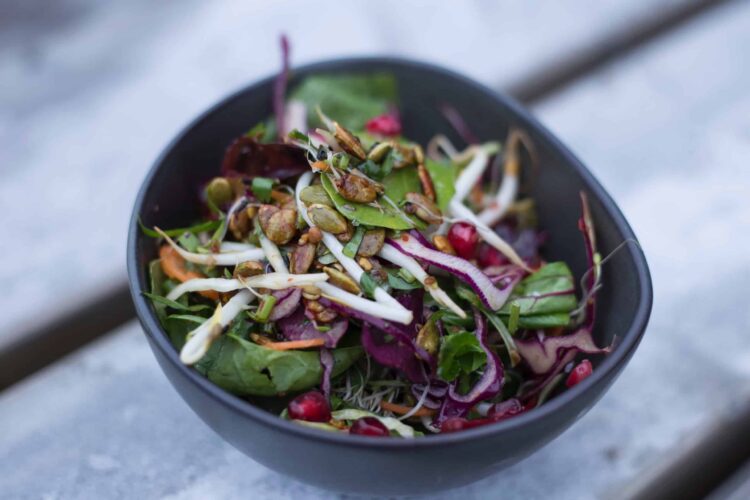Let’s talk about salads – the color, the crunch, an endless choice of fresh, crisp veggies.
(Ok, you had me at crunch.)
Eating one huge salad a day can change your life and make a massive difference in your overall health. Eating raw veggies does excellent things for your body, like helping the digestive system, by providing tons of fiber while nourishing your body with phytochemicals—which are those great antioxidants and other micronutrients that strengthen your immune system, fight cancer and generally work to keep us in tip-top shape.
So how do you make a daily salad? Well, one way would be to go to a store’s salad bar and load up while trying not to drain your wallet. If you go that route, try these 10 hacks to do salad bar surfing on the cheap. Another (far less expensive) way would be to prep a salad for 3–4 days all at once.
Once you commit to eating a salad every day, streamline the process—and keep things fresh (both the veggies and the flavor)! Let’s start with the basics.
Leafy Greens in Salads
Choose a dark, leafy green lettuce, and then select two cruciferous vegetables to go with it. Here are some of my all-time favorites:
- Watercress This slightly peppery-flavored green is a powerhouse, filled with the good stuff that protects your bones and eyes, plus it has the ability to suppress breast cancer cell development.
- Arugula Eating arugula raw in salads, rather than cooked, leaves its amazing anti-inflammatory and anti-cancer enzymes fully intact.
- Cabbage This cruciferous veggie, chewed well, has the ability to help the heart and protect against cancer. Choose red cabbage. Not only does it look pretty, but because of its color, it offers some of the same heart and anti-cancer benefits as berries.
Add Extras to Mix It Up
These can be prepared and refrigerated in separate containers.
- Beans and other legumes
- Peas (green, snow, snap, or sugar peas)
- Fruit (orange slices are a great choice)
- Corn
- Tomato
- Radishes
- Cucumber
- Whole grains such as quinoa
- Peppers
- Onion
- Carrots
To make room in the fridge, shred a few day’s worth of cabbage and carrots and refrigerate them in airtight Ziplock bags. This way, the work of shredding is contained to two days each week, and there is less room needed for storage.
A.B.C.: All beans count! Take several different types of beans and create your own mix. Some favorite combinations are black beans and corn or garbanzo and black beans. Store them in glass dishes so they are ready to scoop out each day to toss atop your salad.
Use Salad Dressing to Create New Flavor Profiles
You can change up your salads as easily as changing your shoes by letting different types of cuisine inspire you.
Feeling a little Tex-Mex today? Make a dressing using avocado, lime, and garlic (recipe below!). Kick it up a notch with cayenne pepper. Or, try a citrus dressing with a hint of Asian flavor (we give you the recipe for that, too). Your flavor profiles can change from week to week, and your salads will never get boring if you change up the dressing now and then. To save time, make a week’s worth of one or two kinds of salad dressings on Sunday and refrigerate them in mason jars. They’ll easily keep a week because the vinegar keeps them from spoiling.
Easy Salad Dressing Hack: Looking for a healthful dressing that doesn’t involve kitchen appliances? Then you’ll love our Easy Balsamic Almond Dressing. Here’s what you’ll need:
- 2 tablespoons water
- 1 tablespoon plus 1 teaspoon balsamic vinegar
- 1 tablespoon raw almond butter
- 1/4 teaspoon onion powder
- 1/4 teaspoon garlic powder
- 1/8 teaspoon dried oregano
- 1/8 teaspoon dried basil
Whisk water, vinegar, and almond butter together until the mixture is smooth and almond butter is evenly dispersed. Mix in the remaining ingredients. Feel free to experiment with other raw, salt-free nut butters, spices, and vinegars to create salad dressings as unique as your fingerprints!
One quick note: Nutritarians know not to use calorie-laden oils in their salad dressing. But Dr. Fuhrman also advises against fat-free salad dressings. Why? Fat helps your body absorb beneficial fat-soluble phytochemicals, like carotenoids – so using a fat-free salad dressing severely limits the health benefits you could obtain by eating salad. For that reason, all the recipes I recommend have dressings made using the healthy fats of nuts and seeds.
Tex-Mex salad with easy avocado dressing
For the salad, you’ll need
- 6 cups romaine lettuce, chopped
- 4 cups mixed baby greens
- 1 cup cooked black beans
- 1 cup frozen, thawed corn kernels
- 1 medium tomato, chopped
- 1/4 cup chopped red onion
For the dressing, you’ll need
- 1 ripe avocado, peeled, pit removed
- 1/2 lime, juiced
- 1 small clove of garlic
- 1 tablespoon nutritional yeast
- pinch of cayenne pepper, or more to taste
Instructions
Place dressing ingredients in a blender or food processor and blend until smooth. Combine salad ingredients in a large bowl and toss with the desired amount of dressing




